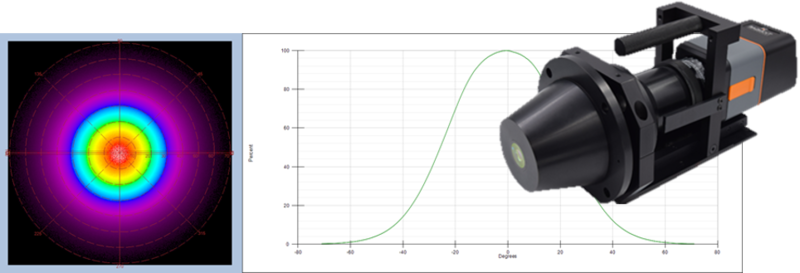On the Road or in the Air, Vehicle Innovation Prioritizes Performance and Safety
Despite an entirely virtual format this year, CES 2021 did not disappoint in the realm of automotive innovation. From the Mercedes-Benz “Hyperscreen” to John Deere’s robot tractor that can seed 500 acres in a day, to multiple concepts for flying cars, vehicle enthusiasts had plenty of interesting new technology to absorb.

The Liberty propeller-driven gyroplane-slash-commuter car from Dutch company PAL-V (left) and the new Cadillac Exhibit Zero (right), an electric vertical takeoff and landing (VTOL) air taxi from General Motors. (images © PAL-V, and © General Motors, respectively)
For example, Israeli firm Mobileye showed its new “lidar on a chip”, which is smaller and lighter than current lidar (light detection and ranging) systems and could improve the performance and safety of self-driving vehicles. Rather than using traditional lidar’s time-of-flight (TOF) sensing method, (which sends out pulses of light in discrete bursts and measures how long it takes each pulse to return to the sensor), “Mobileye’s solution relies on so-called frequency modulated continuous wave (FMCW) technology, which instead sends out a constant stream of light.”1
FMCW systems can calculate both the range and velocity of objects, which make them more effective than TOF. Mobileye’s chips, which could be in production by 2025, can perform highly accurate sensing up to 200 meters, doubling current lidar system range to detect objects and road conditions outside the vehicle.
In-Vehicle Sensing Systems for Driver and Occupant Monitoring
As with lidar, light-based sensing underlies other technology in the automotive sector—namely advanced driver assistance systems (ADAS) such as driver monitoring systems (DMS) and occupant monitoring systems (OMS). Automobile accidents are one of the leading causes of accidental death worldwide; even a few seconds of inattention can have tragic consequences. DMS are enhancing safety in multiple ways, by making use of a range of technologies including embedded vision, sensors, connectivity, automotive systems infrastructure, and automotive human machine interface (HMI) design.2 For example, after-market DMS in the long-haul trucking industry intervene in roughly 100,000 fatigue events each year.3
DMS use visual and biometric indicators about the driver to send a warning or alert in case fatigue or distraction is detected. Many of these systems leverage near-IR or NIR light (wavelengths outside of human visual perception) to maintain unobtrusive, remote sensing of a person’s presence, pupil position and gaze, eyelid movement, and other indicators of driver alertness captured by NIR-sensitive cameras.
A demonstration of Subaru’s award-winning DriverFocus system.
DMS—nicknamed “guardian angel technology”—have been so effective that new industry safety standards are incorporating them to regulate integration into new vehicles. In 2020, the U.S. National Transportation Safety Board (NTSB) recommended DMS for SAE Level 2 semi-autonomous vehicles. The European NCAP added DMS to its revised crash-test safety standards as a requirement for a 5-star rating. By 2022 DMS will be mandatory in multiple vehicle categories across the European Union.4
OMS have been used in commercial vehicles to detect unauthorized passengers or clutter. In the passenger vehicle segment, they are rapidly being incorporated to monitor child safety. For example, the system can alert the driver if a baby has been accidentally left in the car on a hot summer day. With the advent of self-driving taxis, OMS will become important for ensuring passenger health and safety, preventing inappropriate conduct, and detecting objects left behind.
Ensuring Performance of NIR Sensing Systems
Manufacturers incorporate light-based DMS and OMS into vehicles using either NIR LEDs or NIR lasers, typically VCSELs (vertical cavity surface emitting lasers). Because NIR emissions can be dangerous to human vision, these light sources must be carefully measured to ensure their performance is within eye safety tolerances. When measuring an NIR emitter, all angular distribution points must be captured. Missing any point during measurement may mean missing an irregularly strong emission that could prove hazardous to the user, especially with exposure over time.
An NIR light source measurement system should be able to directly measure the intensity of a source across any potential geometric distribution in 3D space. Such a system may employ Fourier optics to capture all angular emission data from a single point (the source) to be evaluated as a 2D image by a radiometric camera.
Radiant’s NIR Intensity Lens solution has been used to measure the accuracy and performance of millions of facial-recognition and eye tracking systems based on NIR light. The solution combines a ProMetric® Y16 Imaging Radiometer with a specially designed Fourier optic lens to capture 3D light emissions across ±70 degrees in a single 2D polar measurement image. This compact system reduces the cost and complexity of angular light source measurement over traditional systems like goniometers, and captures an entire light source distribution (whether a uniform angular distribution of an LED, or pattern produced by a laser) in as little as a second without rotation or moving parts.

Polar plot (left) and cross section (right) showing radiant intensity as a function of angle of an NIR LED, captured by the Radiant NIR Intensity Lens and analyzed in TT-NIRI™ Software. Radiant’s NIR Intensity Lens solution incorporates a ProMetric Y16 Radiometric camera mounted to a specially designed lens (inset).
In a recent interview with Automotive Interiors World, Matt Scholz, Automotive Business Leader at Radiant Vision Systems, discussed vehicle safety expectations and regulations for in-vehicle sensing systems like DMS and OMS. In the interview, Matt describes near-IR light sources like LEDs and VCELs that enable unobtrusive detection of driver presence, position, gaze, eyelid movement, and gestures; and considerations for light source measurement systems to ensure accurate sensing system performance.

CITATIONS
- Barret, B., “Mobileye Puts Lidar on a Chip—and Helps Map Intel’s Future”, Wired, January 11, 2021.
- “Top 5 Tech Trends in Advanced Driver Assistance Systems”, Avnet, March 4, 2017.
- Lampinen, M., “What’s next for driver and occupant monitoring systems”, Automotive World, June 17, 2020.
- “Road safety: Commission welcomes agreement on new EU rules to help save lives,” European Commission press release, March 26, 2019
Join Mailing List
Stay up to date on our latest products, blog content, and events.
Join our Mailing List
